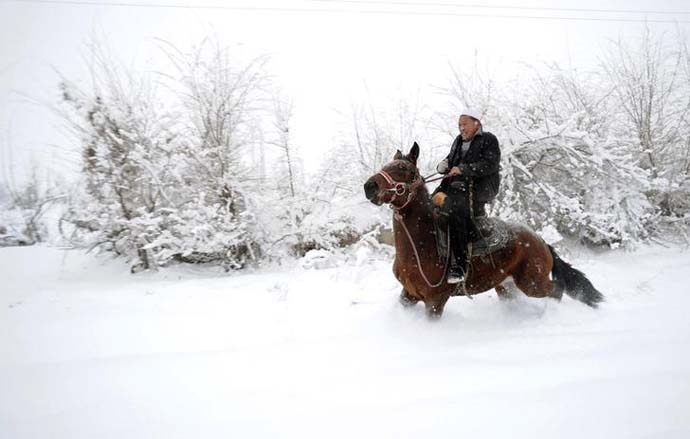How old CIA reports reveal that China has been repressing Muslims since the 1950s

The Uyghurs were not trusted and removed from all their posts; ditto today.
The Human Rights Watch (HRW) has recently released a 117-page report titled, Eradicating Ideological Viruses — China’s Campaign of Repression Against Xinjiang’s Muslims.
It gave fresh evidence of Beijing’s “mass arbitrary detention, torture, and mistreatment, and the increasingly pervasive controls on daily life.”
The US-based agency affirmed: “Throughout the region, the Turkish Muslim population of 13 million is subjected to forced political indoctrination, collective punishment, restrictions on movement and communications, heightened religious restrictions, and mass surveillance in violation of international human rights law.”

History of abuse
Bloomberg, citing a UN assessment, said that the Chinese authorities have detained more than one million Uyghurs: “As its mosques are shuttered and travel across its borders restricted, Xinjiang — once at the intersection of ancient Silk Road trade routes — threatens to become a black hole in President Xi Jinping’s effort to build new ones.”
One only needs to see old reports of the CIA to understand that these tactics have been going on since the 1950s.
One such report of January 1951 states: “Muslims in Sinkiang [Xinjiang] are discontented with the Communist regime. Officially there are no restrictions on prayers, but orchestras play for dancing at evening-prayer time to distract the young, and young men enlisted as soldiers have no time to attend religious services. Gatherings of more than four people are prohibited.”
Another CIA report of September 1952 notes: “Prior to June 1952, the Chinese Communist Government in southwestern Sinkiang Province had adopted a policy of deporting all persons whose families originally migrated to Sinkiang from the area which is now West Pakistan. Deportation was preceded by confiscation of property, and the persons being deported were accompanied to the Sinkiang-Pakistan border by an armed guard.”
Today, the Chinese authorities have detained many Uyghur women married to Pakistani businessmen from the Gilgit-Baltistan region. This has the result of angering Pakistan.

In 1952, two years after the first Chinese troops arrived in former Eastern Turkestan, the CIA says: “All major government departments, including those of agriculture, police, secret police, magistrates, revenue, and engineering, were headed by Chinese officials and advised by Soviet officials.”
The Uyghurs were not trusted and removed from all their posts; ditto today.
In March 1953, a CIA report asserts: “In the fall of 1952 no one was permitted to travel from southwestern Sinkiang …where the authorities were engaged in liquidating large numbers of people accused of having participated in the 1944 revolt against Chinese rule.”
The CIA reported that the fortification walls surrounding Kashgar had been torn down by forced labour: “All women in both cities were compelled to work at removing the debris resulting from the destruction. The men of Kashgar were being forced to work on the construction of roads and buildings.”
Communists take over
Soon all profitable business, including the silk industry in Hotan, was seized by Communist authorities: “Private business was discouraged, and almost all shops had been turned into government owned cooperative stores. The salaries paid to shopkeepers were barely enough to cover their living expenses.”
The new government of Xinjiang told the people: “The Chinese in the administrative structure are there simply to teach the natives of Sinkiang the art of governing, and that soon the full governmental administrative responsibility would be turned over to the people of Sinkiang.”
The same report cited a long list of purges, arrests and executions.

More than 60 years later, ferocious repression and forced assimilation still takes place in the restive region; the Uyghurs face repression, re-education and relocation.
On July 6, The People's Daily noted that Beijing has relocated “461,000 poverty-ridden residents to work in other parts of the region during the first quarter of the year,” in a bid to “improve social stability and alleviate poverty.”
The report asserted that the Xinjiang government planned to further transfer 1,00,000 residents from southern Hotan and Kashgar prefectures by 2019, to get employed somewhere else.
Current practices
Yu Shaoxiang, an ‘expert’ at the Chinese Academy of Social Sciences, told The Global Times: “poverty alleviation in Xinjiang is more difficult compared to other places because, aside from poverty, Xinjiang also faces ethnic issues.”
The irony is that this region is the hub the ‘humanist’ Belt and Road Initiative (BRI) which is to bring prosperity and happiness to the local populations.
China still faces serious challenges, not only from infiltration from its friend in the South, but also from the Syrian-trained Uyghurs returning to Xinjiang.
On August 31, during a hearing at the United Nations Committee on the Elimination of Racial Discrimination (CERD), Hu Lianhe, the Chinese representative countered the claims that the Muslim minorities was being subjected to extrajudicial detention and political indoctrination.
Hu denied the existence of ‘re-education camps’, asserting instead that China is ‘a victim of terrorism’, and that the Xinjiang has only initiated a “special campaign to crack down on violent terrorist activities according to law.”

He, however, admitted to the trial and imprisonment of ‘a number of criminals’ and that people guilty of minor offenses were sent “to vocational education and employment training centers… to assist with their rehabilitation and reintegration”.
Meanwhile, Xinhua promotes the Xinjiang Uygur Autonomous Region, as a ‘paradise on earth’.
It affirms that 130 million tourists visited the Western province during the first nine months of 2018. It is definite that the Han tourists did not visit the re-education camps.
(Courtesy of Mail Today)

